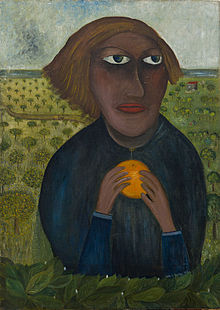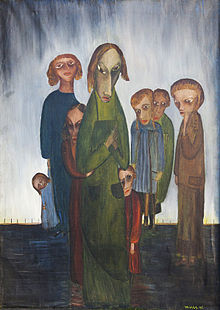Latvian Valeska
Lette Valeska (born August 20, 1885 in Braunschweig ; † January 8, 1985 in Los Angeles ; born as Hella-Hilde Heinemann , married Heymann or Valeska Heymann , also Heynemann or Heinemann) was a German - American photographer , painter and sculptor .
In 1937 she emigrated to New York City with her husband and daughter . In 1938 the couple separated and Valeska moved to Los Angeles, where she called herself Lette Valeska and spent the rest of her life there.
She started out as a child portrait photographer and quickly gained notoriety among Hollywood film industry celebrities . Valeska began painting at the age of fifty and sculpture at the age of seventy.
Early years
Her parents were the Jewish businessman Berthold Heynemann and Heinemann (1852–1930), who lived in Braunschweig, and his wife Fanny, née. Kunstmann (1854-1942). She had the three brothers Ludwig (1882–1942), Walter (1883–1968) and Fritz Heinemann (1893–1918). The family lived in Petritorwall 30.
From 1891 to 1901 Valeska Heymann attended the secondary school for girls, which is now the Kleine Burg grammar school in downtown Braunschweig. Valeska had been friends with Galka Scheyer since her school and university days . In addition, she received additional lessons in English, French and Italian from private tutors. She started taking pictures at the age of twelve. She did not receive any artistic training. From 1911 to 1914 she worked as a secretary for a technical journal in Brussels . In 1920 Valeska married the entrepreneur Ernst Heymann, owner of a factory for chemical and pharmaceutical products in Frankfurt am Main . The couple lived there with their daughter Hella until 1932, when the family moved to Paris because Ernst Heymann wanted to open a company branch there. In 1937 the family wanted to return to Frankfurt, but this was prevented by anti-Semitic company employees, so that they emigrated to New York in the same year. The chemical factory Frankfurt a. M. Ernst Heymann & Co. was confiscated by the Nazi regime and dissolved in 1939. In 1938 Valeska and Ernst Heymann separated. Valeska moved to Los Angeles at the suggestion of her childhood friend, the painter and art collector Galka Scheyer, who was also from Braunschweig. 1948 committed Ernst Heymann suicide .
Photographic work
On July 15, 1938, Scheyer reported from Hollywood to Jawlensky : Valeska “will learn photography in order to finally move away from purely business into a more artistic activity.” Shortly after arriving in Los Angeles, she was commissioned to teach children at a primary school taking photos.
Valeska's photographs of school children caught the attention of Hollywood celebrities. The film producer David Selznick (1902–1965) commissioned her to portray actors after he was impressed by the photographs of his children. This opened up a career as a portrait photographer, in which she photographed Gregory Peck , Joseph Cotten , Danny Kaye , Gene Kelly , Ingrid Bergman , Mickey Rooney , Doris Day , Rita Hayworth , Ava Gardner , James Stewart and Elizabeth Taylor , among others . Valeska did not work in the studio, but mostly in the houses and apartments of her models in order to show people in their familiar surroundings.
Visual arts
The German-American painter, art dealer and art collector Galka Scheyer, a friend from Braunschweig's childhood days, encouraged Valeska to start painting in 1939. At that time, Valeska was 54 years old and had not previously received any artistic training. Galka Scheyer was experienced in bringing up children as artists and encouraged them to paint spontaneously and expressively. She welcomed Valeska's inexperience with the medium of painting. Valeska developed her own style with mostly elongated faces and a wealth of details and color.
Her art shows Jewish religious motifs and life even though she did not grow up in a religious household. Her relatives and her own experiences with the Nazi regime motivated her to rediscover her Jewish roots. When she moved to Los Angeles, she studied Jewish history and literature, joined the Zionist women's organization Hadassah and participated in other Jewish organizations.
Valeska began sculpting in clay in 1955 at the age of 70 . In this artistic technique, too, she continued to depict Jewish subjects. Her sculptures were exhibited in 1966 at Brandeis University in Waltham, Massachusetts , and in 1980, alongside her paintings and photographs, in a solo exhibition at the Los Angeles Jewish Community Center and other venues.
social commitment
In November 1945, after the end of World War II, Valeska started a friendship campaign between children from Los Angeles and the Dutch city of Rijswijk . Residents there had protected Jewish citizens from deportation . With the help of Valeska and her supporters, over 2000 children in the Dutch city were provided with food and clothing.
After the death of her friend Galka Scheyer at the end of 1945, Lette Valeska organized her archive and estate . She also wrote the book "Galka Emmy Scheyer and the Blue Four". In 1973 Lette Valeska was awarded the Federal Cross of Merit, 1st Class , for her services to Scheyer .
Valeska supported Weiler's Jawlensky book
The first great biography of the Russian painter Alexej Jawlensky by Clemens Weiler would have gaps if he had not been supported by Valeska. The author specifically points out this in the introduction to his book: “My thanks go to Mrs. Lotte Valeska in Los Angeles, who was always willing to extract extracts from the correspondence of her late friend Emmy Scheyer. Mr. Levitt generously supported the work by allowing Mrs. Valeska to inspect the Scheyer's correspondence, which is dormant in the Pasadena Museum of which he is director. "
literature
- Reinhard Bein : Eternal House: Jewish cemeteries in the city and country of Braunschweig . Döring Druck, Braunschweig 2004, ISBN 3-925268-24-3 .
- Isabel Wünsche (Ed.): Galka E. Scheyer & Die Blaue Vier, Correspondence 1924-1945. Wabern / Bern 2006
- Reinhard Bein: Lette Valeska. In: Life stories of Braunschweig Jews. Döring Druck, Braunschweig 2016, ISBN 978-3-925268-54-0 , pp. 274-281.
- Reinhard Bein: You lived in Braunschweig. Biographical notes on the Jews buried in Braunschweig (1797 to 1983) . ( Messages from the Braunschweig City Archives . 1.) Döring Druck, Braunschweig 2009, ISBN 978-3-925268-30-4 .
Web links
- Lette Valeska: Hollywood Constellations , exhibition at the American Center Prague, September 5 to November 5, 2013, accessed on October 13, 2013.
Individual evidence
- ↑ a b c d Bein: Eternal House. Jewish cemeteries in the city and country of Braunschweig . Döring, Braunschweig 2004, ISBN 3-925268-24-3 , p. 220.
- ↑ Bein: You lived in Braunschweig. Biographical notes on the Jews buried in Braunschweig (1797 to 1983) . P. 495.
- ↑ Bein: Eternal House - Jewish cemeteries in the city and country of Braunschweig . P. 219.
- ↑ Bein: You lived in Braunschweig. Biographical notes on the Jews buried in Braunschweig (1797 to 1983) . P. 494f.
- ↑ Bein: You lived in Braunschweig. Biographical notes on the Jews buried in Braunschweig (1797 to 1983) . P. 423
- ↑ a b Bein: You lived in Braunschweig. Biographical notes on the Jews buried in Braunschweig (1797 to 1983) . P. 496
- ↑ a b c Bein: You lived in Braunschweig. Biographical notes on the Jews buried in Braunschweig (1797 to 1983) . P. 495
- ↑ Isabel Wünsche (Ed.): Galka E. Scheyer & Die Blaue Vier, Correspondence 1924-1945. Wabern / Bern 2006, p. 279, note 169
- ↑ Marti Coale: The Heart Is Not Wrinkled . In: Modern Maturity . 14, No. 1, Feb.-Mar. 1971, p. 22.
- ↑ a b c d Kolma Flake: Arrested Moments . In: Minicam Photography . 9, No. 1, September 1945, pp. 50-55.
- ↑ Chemical apparatus . Volumes 26-27, 1939, p. 72.
- ^ Virginia Horn: Lette Valeska - Richness of Creativity . In: Los Angeles Times . August 20, 1965.
- ↑ Isabel Wünsche (Ed.): Galka E. Scheyer & Die Blaue Vier, Correspondence 1924-1945. Wabern / Bern 2006, p. 279
- ^ LC Green: Valeska . In: The American Hebrew. January 6, 1950, pp. 5, 12-13.
- ^ Mira Hamermesh: Paintings of the Ghetto . In: Zionist Review. May 21, 1950, pp. 13-15.
- ↑ Catherine McDonald: Little Miss Somebody . In: The Villager . January 1, 1946.
- ↑ Valeska's excerpts, Jawlensky's correspondence with Emmy Scheyer, Kandinsky and other friends, including copies and copies, are now in the archives of the Murnau Castle Museum
- ↑ Clemens Weiler: Alexej Jawlensky. Cologne 1959, p. 12
| personal data | |
|---|---|
| SURNAME | Valeska, Lette |
| ALTERNATIVE NAMES | Heinemann, Hella-Hilde (maiden name); Heymann, Lette; Heymann, Valeska |
| BRIEF DESCRIPTION | German-American photographer, painter and sculptor |
| DATE OF BIRTH | August 20, 1885 |
| PLACE OF BIRTH | Braunschweig |
| DATE OF DEATH | January 8, 1985 |
| Place of death | los Angeles |


